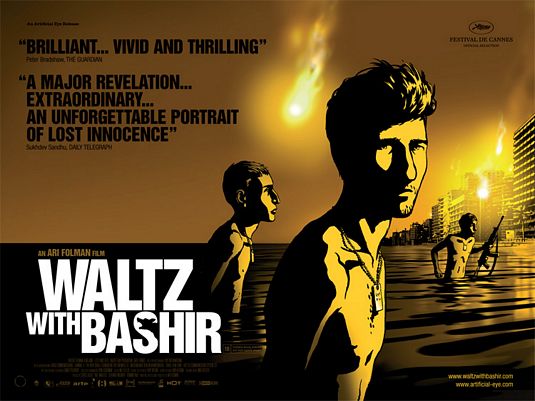 Winner of more than 20 film awards including a Golden Globe for Best Foreign Language Film in 2008, “Waltz With Bashir,†written and directed by Ari Folman, a war veteran, is truly one of a kind and a must see for everyone.
Winner of more than 20 film awards including a Golden Globe for Best Foreign Language Film in 2008, “Waltz With Bashir,†written and directed by Ari Folman, a war veteran, is truly one of a kind and a must see for everyone.
The first feature-length animated Israeli documentary to be shown in theaters, gives an unconventional look into the 1982 Lebanon War and its after effects.
After meeting up with an old army friend who tells him of a reoccurring nightmare, Folman is baffled as to why he cannot remember a thing from his service. That night, nearly 24 years after the war, Folman has a flashback about the Sabra and Shatila massacre, but is unable to separate reality from fantasy.
On his quest for the truth about his role in the genocide, Folman interviews old comrades of war, seeks help from a lawyer friend and a psychologist to try and make sense of it all.
Despite the unusual, but superb choice of animating the war as opposed to actual footage, the film is set up in a typical documentary format. The interviewees recall the experiences they had on duty and are intercepted by the animated recreations. The voice-overs are clearly heard against the loud explosions and gunfire.
With the help of many independent film companies, “Waltz With Bashir†was completed after four years of endless drawing by a team of 12 animators and six artists including Director of Animation Yoni Goodman and Art Director and Illustrator David Polonsky.
Goodman created a unique animation style that fuses classical animation and Adobe Flash cutouts giving the scenes a surreal effect. The animation and intense reconstructions of battles are easy to get lost in. The radiating glow of the auburn skies and muddy grays establish the tone from the opening scene of the vicious dogs to Folman’s repeating beach vision. The grimness and devastation is captured so well that you forget you’re watching a cartoon. In some respect, a graphic novel influence is noticeable.
Only the beginning and middle of the documentary is animated, setting up the overwhelming impact of the unexpected ending. Actual footage of the Sabra and Shatila massacre is shown. None of the prior scenes can prepare you for the complete chaos and body count exhibited. The Palestinian womens’ violent screams and sobs as they enter the refugee camps and witness the carcasses of their male relatives and children among the rubble are chilling. Definitely not a sight for those with weak stomachs and heavy hearts.
The sound effects gave it an authentic feel. Every gun shot, bomb explosion, flare launch, savage bark and ocean ripple was convincing.
Unlike most foreign language movies, there are no complaints about the subtitles. The words do not get camouflaged against the hues of the clips nor are they rushed off the screen.
Featuring original music by composer Max Ritcher and his bow instruments quartet, the music spans from soft classical orchestra to upbeat electronica with English lyrics to corky rock songs about a typical day at war. The music added to the movie’s steadfast attitude.
There are many striking clips throughout the documentary, whether it be the haunted ocean or the mythological naked woman that rises from the sea. However, one in particular that is the namesake of the movie is quite touching.
An infantry unit commander and interviewee, Shmuel Frenkel, takes a machine gun by force from a fellow solider and runs into the middle of the street amid enemy fire. Frenkel gracefully twirls around shooting his weapon and dodging bullets to Chopin’s Waltz in C Sharp all the while posters of President Elect Bashir trim the area.
Folman’s “Waltz With Bashir†pieces together the events of the Lebanon War as he understands and processes the recalls of his respondents while dealing with post traumatic stress disorder. A work of art that weaves dreamlike incidents of memory lapse with reality.

Leave a Reply